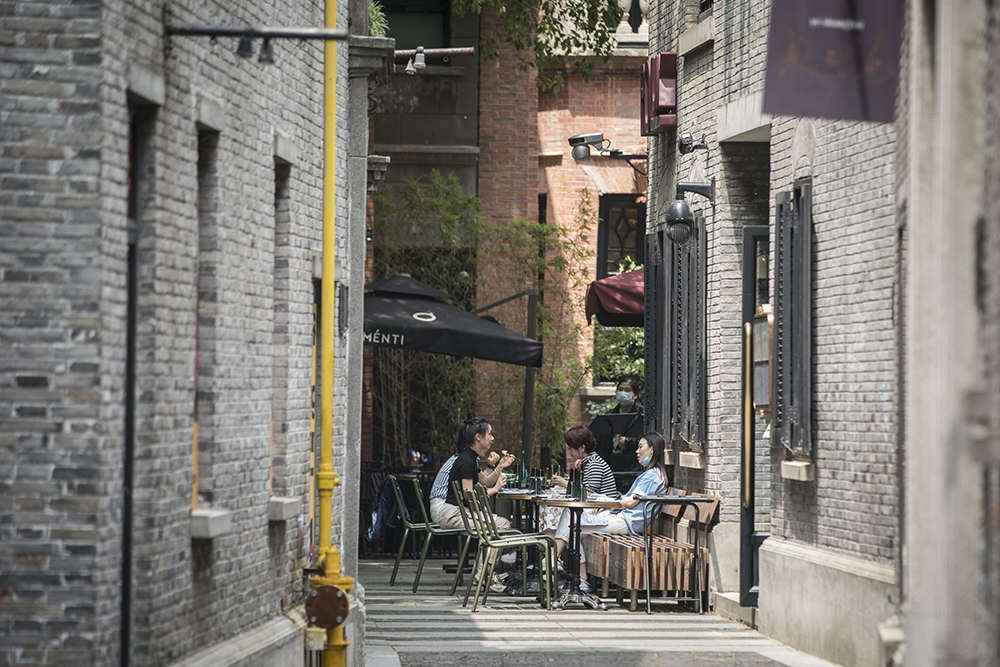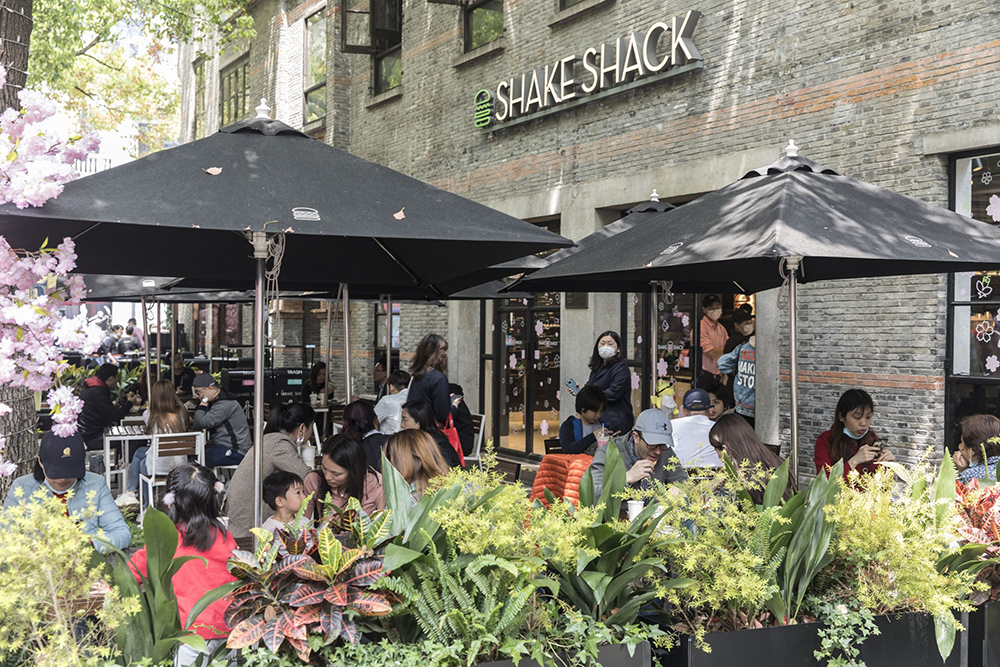 伍奔騰(Benjamin Travis Wood)因說服中國地產(chǎn)開發(fā)商重視歷史遺跡保護而受到建筑師同行的稱贊,。圖片來源:FORTUNE CHINA
伍奔騰(Benjamin Travis Wood)因說服中國地產(chǎn)開發(fā)商重視歷史遺跡保護而受到建筑師同行的稱贊,。圖片來源:FORTUNE CHINA在中國的20年間,建筑師伍奔騰(Benjamin Travis Wood)曾經(jīng)幫助打造了十多個將歷史建筑風格與現(xiàn)代商務(wù)相融合的商業(yè)項目,,最知名的莫過于上海熱鬧非凡的新天地商業(yè)區(qū),。在那里,,人們會發(fā)現(xiàn),Shake Shack和蒂芙尼這樣的品牌均坐落于19世紀風格的建筑中,。
如今,,伍奔騰希望更多的建筑設(shè)計同行放棄充斥于現(xiàn)代建筑的玻璃與鋼鐵,轉(zhuǎn)而采用更加傳統(tǒng)的材料和設(shè)計,。伍奔騰在11月2日于上海舉行的《財富》ESG峰會上表示:“不管是天然的石材,、木料……,當前這個世界上我們可以使用的最可持續(xù)資源都有哪些,?”這些材料“被忽視了,,因為當前在座的各位高樓大廈的設(shè)計師奉行的都是“五十度灰”?!?/p>
他說:“如果可以使用色彩的話,,為什么要一直“50度灰”呢?這并不是建筑風格方面的問題,,而是一個富有深意的問題——這種材料到底意味著什么,?”

伍奔騰如今經(jīng)營著建筑設(shè)計公司Studio Shanghai,該公司位于中國的超大城市上海,,他因其在項目中保護建筑歷史樣貌的理念而聞名,。他最知名的作品可能莫過于新天地項目,這是一個在2001年開業(yè)的購物街項目,,高樓聳立,,毗鄰老上海法租界。他的另一個知名項目是芝加哥軍人球場(Soldier Field)重建項目,,這個于2003年開展的項目引發(fā)了爭議,。該項目在保留老場館外立面的同時對內(nèi)部進行了翻修。
開發(fā)之初,,上海將新天地再開發(fā)合約授予了香港開發(fā)商瑞安及其所有者羅康瑞,,但提出了一個條件:這位億萬富翁必須保留部分當?shù)亟ㄖ?/p>
伍奔騰還記得,他們必須保護該地區(qū)的“石庫門”建筑,,這些建筑建于19世紀中期,,融合了中西方的建筑風格。在第一次到訪老上海法租界后,,伍奔騰稱自己記得當時想過:“所有這些建筑都可能會被拆掉,。”
他說:“天哪,,不能拆,?!?/p>

在重建新天地的時候,建造者小心翼翼地拆除了老建筑,,然后在重建時使用了相同的天然材料,,并還原了此前的建筑樣式,僅在輔材上采用了現(xiàn)代材料,,例如最先進的電線和管道。
自那之后,,伍奔騰的建筑師同行稱贊其展現(xiàn)了保護老建筑的價值,。《建筑實錄》(Architectural Record)雜志編輯克里夫·皮爾森在2006年對《紐約時報》(The New York Times)說:“中國需要伍奔騰這樣的人來證明,,拯救老建筑比拆掉老建筑更賺錢,。此前沒有人做過此事,因為從零開始要簡單得多,?!?/p>
如今,新天地基本都是商場和高樓,,而被其包圍在中間的則是古香古色的矮樓名品店,、備受歡迎的餐廳以及紀念中國共產(chǎn)黨誕生的博物館。

伍奔騰最新的項目是上海蟠龍?zhí)斓?,其合作方依然是羅瑞康與瑞安,,這是一個商業(yè)綜合體,位于上海東南部,,由郊區(qū)村落改造而來,。開發(fā)商稱,這片商業(yè)街開業(yè)第一天的客流量達到了約20萬,,而且開業(yè)數(shù)月內(nèi)的客流量亦是如此,。
他在《財富》ESG峰會上表示,,在中國經(jīng)濟大范圍放緩的背景下,,蟠龍?zhí)斓貙χ袊徫镎叩奈芍^是一個亮點,尤其是其房地產(chǎn)板塊,。
他說:“中國正面臨經(jīng)濟危機,。僅靠建造更多的高樓是解決不了問題的,。”他建議,,“人們反而可以通過回歸更加社區(qū)式的生活來解決問題,。”
自中國在約一年前解除新冠限制令后,,其經(jīng)濟恢復(fù)并不順利,。消費的復(fù)蘇態(tài)勢并未達到政府預(yù)期,也為當?shù)睾屯鈬編砹藟毫?。民營開發(fā)商為了建造更多的房地產(chǎn)項目而過度借貸,,該行業(yè)的蕭條也拉低了消費意愿。
在《財富》ESG峰會上,,伍奔騰呼吁會議參與者不斷改善其設(shè)計,。
他說:“城市是你一手造就的。因此,,如果你都不去貫徹宜居城市理念,,那就只能聽天由命了?!保ㄘ敻恢形木W(wǎng))
想聆聽更多設(shè)計師討論在一個被技術(shù)重塑的時代,,他們正在如何設(shè)計產(chǎn)品、居所,、娛樂與企業(yè)文化嗎,?《財富》將于12月6日在中國澳門美獅美高梅酒店舉辦Brainstorm Design (“設(shè)計頭腦風暴”大會)。大會將云集逾20位世界頂級設(shè)計師,、學(xué)者,、藝術(shù)家與企業(yè)設(shè)計主管,,以“人工智能時代的同理心(Empathy in the Age of AI”為主題,,探索新技術(shù)如何顛覆創(chuàng)意行業(yè),。欲了解更多大會詳情或注冊參會,請掃描下圖中的二維碼,。

譯者:馮豐
審校:夏林
伍奔騰(Benjamin Travis Wood)因說服中國地產(chǎn)開發(fā)商重視歷史遺跡保護而受到建筑師同行的稱贊。
在中國的20年間,,建筑師伍奔騰(Benjamin Travis Wood)曾經(jīng)幫助打造了十多個將歷史建筑風格與現(xiàn)代商務(wù)相融合的商業(yè)項目,,最知名的莫過于上海熱鬧非凡的新天地商業(yè)區(qū)。在那里,,人們會發(fā)現(xiàn),,Shake Shack和蒂芙尼這樣的品牌均坐落于19世紀風格的建筑中,。
如今,伍奔騰希望更多的建筑設(shè)計同行放棄充斥于現(xiàn)代建筑的玻璃與鋼鐵,,轉(zhuǎn)而采用更加傳統(tǒng)的材料和設(shè)計,。伍奔騰在11月2日于上海舉行的《財富》ESG峰會上表示:“不管是天然的石材、木料……當前這個世界上我們可以使用的最可持續(xù)資源都有哪些,?”這些材料“被忽視了,因為當前在座的各位高樓大廈的設(shè)計師奉行的都是“五十度灰”,。”
他說:“如果可以使用色彩的話,,為什么要一直“50度灰”呢?這并不是建筑風格方面的問題,,而是一個富有深意的問題——這種材料到底意味著什么,?”
在2003年重建芝加哥的Soldier Field體育場時,,伍奔騰對內(nèi)飾進行調(diào)整的同時盡力保存建筑的原始外貌,,圖為重建完成不久后的照片,。
伍奔騰如今經(jīng)營著建筑設(shè)計公司Studio Shanghai,該公司位于中國的超大城市上海,,他因其在項目中保護建筑歷史樣貌的理念而聞名,。他最知名的作品可能莫過于新天地項目,,這是一個在2001年開業(yè)的購物街項目,高樓聳立,,毗鄰老上海法租界,。他的另一個知名項目是芝加哥軍人球場(Soldier Field)重建項目,這個于2003年開展的項目引發(fā)了爭議,。該項目在保留老場館外立面的同時對內(nèi)部進行了翻修,。
開發(fā)之初,上海將新天地再開發(fā)合約授予了香港開發(fā)商瑞安及其所有者羅康瑞,,但提出了一個條件:這位億萬富翁必須保留部分當?shù)亟ㄖ?/p>
伍奔騰還記得,,他們必須保護該地區(qū)的“石庫門”建筑,這些建筑建于19世紀中期,融合了中西方的建筑風格,。在第一次到訪老上海法租界后,,伍奔騰稱自己記得當時想過:“所有這些建筑都可能會被拆掉?!?/p>
他說:“天哪,,不能拆?!?/p>
上海新天地項目模仿了“石庫門”或“石門”的建筑風格,,后者是一種中式和西式設(shè)計的融合,出現(xiàn)于19世紀,。
在重建新天地的時候,,建造者小心翼翼地拆除了老建筑,然后在重建時使用了相同的天然材料,,并還原了此前的建筑樣式,,僅在輔材上采用了現(xiàn)代材料,例如最先進的電線和管道,。
自那之后,,伍奔騰的建筑師同行稱贊其展現(xiàn)了保護老建筑的價值?!督ㄖ嶄洝罚ˋrchitectural Record)雜志編輯克里夫·皮爾森在2006年對《紐約時報》(The New York Times)說:“中國需要伍奔騰這樣的人來證明,,拯救老建筑比拆掉老建筑更賺錢。此前沒有人做過此事,,因為從零開始要簡單得多?!?/p>
如今,,新天地基本都是商場和高樓,而被其包圍在中間的則是古香古色的矮樓名品店,、備受歡迎的餐廳以及紀念中國共產(chǎn)黨誕生的博物館,。
新天地是中國歷史與現(xiàn)代商業(yè)的混合體,Shake Shack就在路邊,,而盡頭是慶祝中國共產(chǎn)黨誕生的博物館,。
伍奔騰最新的項目是上海蟠龍?zhí)斓兀浜献鞣揭廊皇橇_瑞康與瑞安,,這是一個商業(yè)綜合體,,位于上海東南部,由郊區(qū)村落改造而來,。開發(fā)商稱,,這片商業(yè)街開業(yè)第一天的客流量達到了約20萬,而且開業(yè)數(shù)月內(nèi)的客流量亦是如此。
他在《財富》ESG峰會上表示,,在中國經(jīng)濟大范圍放緩的背景下,,蟠龍?zhí)斓貙χ袊徫镎叩奈芍^是一個亮點,尤其是其房地產(chǎn)板塊,。
他說:“中國正面臨經(jīng)濟危機,。僅靠建造更多的高樓是解決不了問題的?!彼ㄗh,,“人們反而可以通過回歸更加社區(qū)式的生活來解決問題?!?/p>
自中國在約一年前解除新冠限制令后,,其經(jīng)濟恢復(fù)并不順利,。消費的復(fù)蘇態(tài)勢并未達到政府預(yù)期,,也為當?shù)睾屯鈬編砹藟毫?。民營開發(fā)商為了建造更多的房地產(chǎn)項目而過度借貸,,該行業(yè)的蕭條也拉低了消費意愿,。
在《財富》ESG峰會上,,伍奔騰呼吁會議參與者不斷改善其設(shè)計,。
他說:“城市是你一手造就的。因此,,如果你都不去貫徹宜居城市理念,,那就只能聽天由命了,?!保ㄘ敻恢形木W(wǎng))
想聆聽更多設(shè)計師討論在一個被技術(shù)重塑的時代,,他們正在如何設(shè)計產(chǎn)品,、居所、娛樂與企業(yè)文化嗎,?《財富》將于12月6日在中國澳門美獅美高梅酒店舉辦Brainstorm Design (“設(shè)計頭腦風暴”大會),。大會將云集逾20位世界頂級設(shè)計師,、學(xué)者,、藝術(shù)家與企業(yè)設(shè)計主管,以“人工智能時代的同理心(Empathy in the Age of AI”為主題,,探索新技術(shù)如何顛覆創(chuàng)意行業(yè),。欲了解更多大會詳情或注冊參會,,請掃描下圖中的二維碼,。
譯者:馮豐
審校:夏林
Ben Wood's fellow architects credit him with persuading China's developers to value historical preservation.
In his two decades in China, architect Ben Wood has helped build over a dozen commercial projects that combine historic architectural styles with modern commerce—most famously in Shanghai’s buzzy Xintiandi area, where you can find a Shake Shack or a Tiffany’s housed in a 19th-century styled building.
Now Wood wants more of his fellow designers to ditch the glass and steel of modern buildings and embrace more traditional materials and designs. “Whether it’s natural stone, wood…what’s the most sustainable resource we have in this world right now?” Wood said last Thursday at Fortune China’s ESG Summit in Shanghai, China. These materials are “overlooked by the ‘50 Shades of Grey’ that high-rise architects are selling people in this room today.”
“Why buy ‘50 Shades of Grey’ when you can have color?” Wood said. “It’s not a stylistic issue, it’s a meaning issue, of what does that material mean?”
For Chicago’s Soldier Field stadium, pictured soon after its renovation in 2003, architect Ben Wood tried to preserve the original facade while redoing the interior.
Wood, who now runs Studio Shanghai, an architectural design firm based in the Chinese megacity, is famous for wanting to protect historic styles in his projects. The architect is perhaps best known for his work on Xintiandi, a high-rise shopping district near the city’s French Concession that opened in 2001, and the controversial 2003 redesign of Chicago’s Soldier Field, which preserved the external facade of the old stadium while renovating the interior.
Shanghai awarded the Xintiandi redevelopment contract to Hong Kong-based developer Shui On and its owner Vincent Lo on one condition: That the billionaire tycoon preserve some of the local architecture.
Wood remembers the need to preserve the area’s “shikumen” architecture, a unique blend of Chinese and Western styles from the mid-19th century. Upon visiting the French Concession for the first time, Wood says he remembered thinking, “All these buildings are going to be torn down.”
“My god, you can’t do that,” he said.
Shanghai’s Xintiandi emulates the “Shikumen,” or “stone gate,” style: a mix of Chinese and European designs that came to the fore in the 19th century.
When it came time to rebuild Xintiandi, builders carefully dismantled the old buildings, then used the same natural materials to rebuild them in the same architectural style, only with modern trappings like up-to-date wiring and plumbing.
Wood’s fellow architects have since credited him for showing the value in preserving old buildings. “China needed someone like Wood to show them you can make more money by saving rather than tearing down old buildings. No one had done that before because it was so much easier to work with a blank slate,” Cliff Pierson, an editor at Architectural Record magazine, told The New York Times in 2006.
Today, Xintiandi is mostly shopping malls and high-rises, surrounding a historic-styled, low-rise compound of high-end shops, popular eateries, and a museum honoring the birthplace of the Chinese Communist Party.
Xintiandi is a jumble of Chinese history and modern commercialism, where a Shake Shack is down the road from a museum honoring the birth of the Communist Party of China.
Ben Wood’s latest project—again developed with Vincent Lo and Shui On—is Panlong Tiandi, a commercial complex built from a renovated suburban village in southwestern Shanghai that opened in May. The developer says the shopping district attracted about 200,000 visitors a day after its launch, and has continued to attract similar numbers in the months since.
Panlong Tiandi’s popularity with Chinese shoppers is a bright spot amid a wider slowdown in China’s economy, particularly in its property sector, which Wood referred to last week.
“China is facing an economic crisis,” Wood said. “It won’t be solved by building more tall buildings.” Instead, it “will be solved by returning…to a more community-oriented life,” Wood suggests.
The country’s economic recovery has stumbled since the country lifted COVID restrictions almost a year ago. Consumption is not recovering as quickly as officials had hoped, putting pressure on local and foreign companies alike. A property bust—triggered by private developers who borrowed excessive sums of money to build more projects—is also dragging down a willingness to spend.
On Thursday, Wood called on conference attendees to push for better urban designs.
“You get the cities you deserve,” he said. “So if you don’t insist on a livable city? God help them.”






